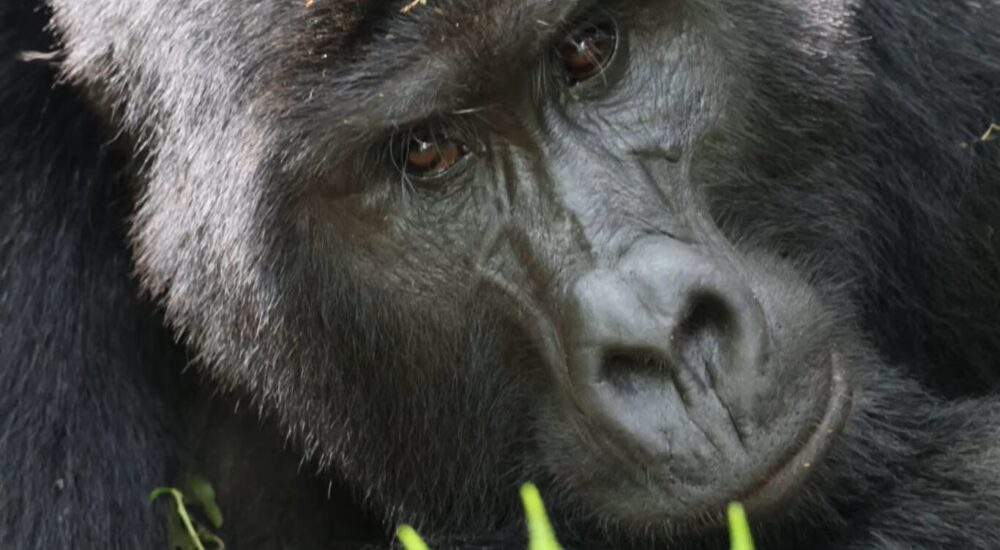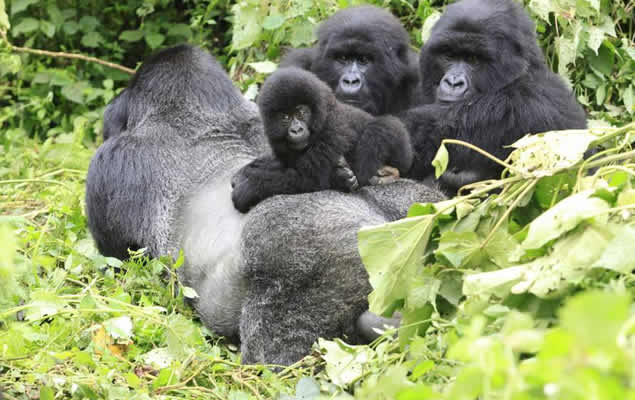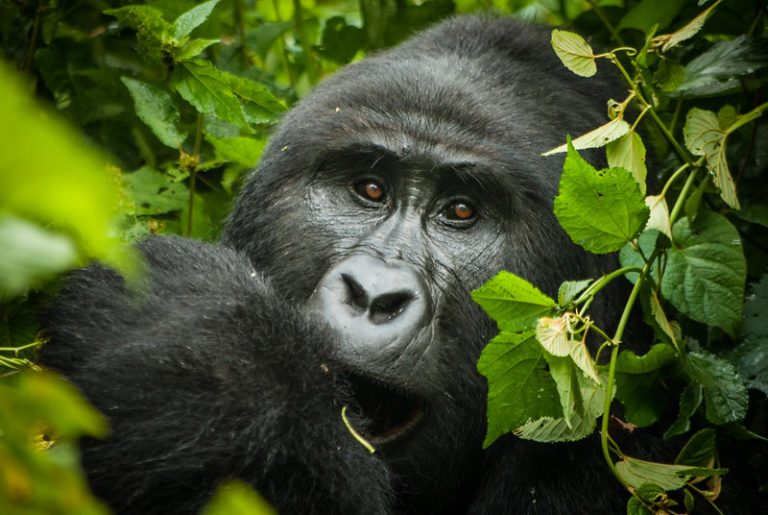What is Gorilla Trekking? Best Destinations for Family-Friendly Gorilla Trekking Preparing for Your Gorilla…
Mountain Gorillas
Mountain Gorillas, The mountain gorilla, or Gorilla beringei beringei, is the world’s biggest living primate. It is a giant primate, or great ape, that lives only in East and Central Africa. It’s bigger and stronger than other gorilla species, and its fur is thicker and longer, which helps it live only in harsh conditions like high elevations and very cold temperatures. Just like human thumbprints, each mountain gorilla has a unique nose print.
The gorilla is the biggest member of the ape family. Most gorillas are vegetarians, which means they eat plants, but some are omnivores and eat small animals for meat. Because of this, they mostly live in the tropical forests of central Africa. Gorillas spend most of their time on the ground, but you can sometimes find them deep in the bush.
East African Travel Permit
The eastern and western gorillas, as well as maybe four or five types, are all in the genus Gorilla. After chimps and bonobos, the gorilla is thought to be the next most closely related live creature to humans. To explain this, they have between 95 and 99% of the same human DNA, based on the similarity.
At the moment, there are two main species of gorillas: the western gorilla and the eastern gorilla. Each species has two subspecies. The well-known mountain and lowland gorillas are both in the eastern gorilla species. There are two types of western gorillas: cross-river gorillas and western lowland gorillas. Only their sizes and the sounds they make to talk to each other are different between these two kinds. If they live in different places, that could be another difference. Also, the eastern gorilla is usually bigger than the western gorilla. But the loss of their natural habitats connects all of them.
Gorillas in the forest
As was already said, mountain gorillas are from the Eastern gorilla species (Gorilla beringei). You can find them in Uganda, Rwanda, and the Virunga Mountains in Congo. In the area, there are about 1000 mountain gorillas. Because of habitat loss for farming and human population, as well as poaching for bushmeat, these numbers have dropped by more than 70% in the last 20 years. The IUCN has called mountain gorillas a “endangered species” because of this.
One of the most interesting animals in the world is the mountain gorilla. People believe that meeting these great apes is one of the best ways to see wildlife in Africa because they look and act a lot like people. The only places you can find mountain gorillas are in the Democratic Republic of the Congo, Rwanda, and Uganda.
More than half of the living mountain gorillas live in Uganda, which is where most of the sightings happen. This has made Uganda Gorilla Safaris more popular, since people can now hike with these big cats in Mgahinga and Bwindi Impenetrable National Parks. They can also be found in Volcanoes National Park in Rwanda and Virunga National Park in the Democratic Republic of the Congo. Mountain gorillas have thick black fur that makes them stand out from the brownish western and eastern lowland gorillas. Also, their arms are shorter than those of coastal species.
How Much Does It Cost to Go Trekking in Uganda?
Mountain gorillas are trained to get used to people through a process called “gorilla habituation” before they are let guests trek with them. For two to three years, gorillas get used to their new surroundings. During that time, experts keep visiting a known group of wild gorillas every day. They learn more about certain gorillas’ habits and how they act. Over time, as the experts get to know each gorilla, they give them a name. Once scientists are sure that these mountain gorillas can be walked, they do a practice run with a small group of tourists, which could include scientists and members of the media. To go hiking with a gorilla family, you have to wait until they have finished a practice exercise.
Going on a gorilla trek in Uganda
To go gorilla trekking in Uganda, you have to walk through the country’s tropical woods to see mountain gorillas where they live naturally. Most people who go on safari to Uganda go gorilla trekking because it is so beautiful there. Trekking with mountain gorillas is the best thing to do in Uganda, and in a lot of ways, mountain gorillas are the main reason people choose to travel there.
In Uganda, the main places to go gorilla climbing are Bwindi Impenetrable Forest National Park and Mgahinga Gorilla National Park. Bwindi Impenetrable Forest National Park is the best place for tourists to see gorillas in their natural environment and the most famous safari spot in Uganda for gorilla trekking. It is home to 22 habituated gorilla families. There are also over 120 species of mammals, 348 species of birds, and 11 species of reptiles in the park.
How Much Does It Cost to Go Trekking in Uganda?
Going on a gorilla trek in Rwanda Most people who visit Volcanoes National Park in Rwanda go gorilla hiking, and there is a very good chance that they will see mountain gorillas. To find one of Rwanda’s gorilla families, people go gorilla trekking, which means hiking through dense bamboo woods and steep mountain slopes. Many people think that the last meeting with the monkeys was one of the most exciting and memorable parts of African Gorilla Trekking in Rwanda.
You could watch the monkey kids play for hours on end. There is always something new and fun for mountain gorillas to do. Some people may come up to you, but they won’t be mean. When you’re with the gorillas, it’s important to stay cool and listen to your Guides. Don’t make sudden moves. Tracking gorillas in Volcanoes National Park can take anywhere from one to six hours, based on which group you are with and where they are on the day of the trek.
Congo goes on a gorilla trek
Mountain gorillas are one of the most important animals to see on a tour in Virunga National Park. There are eight groups of habituated gorillas in Virunga National Park. The Kabirizi family has 32 members and is the most popular and largest. No matter which group of gorillas you’re tracking, the trip usually starts with a lecture in the early morning.
After the explanation, Park Rangers take trekkers to where the gorilla family lives. It could take anywhere from one to four hours to find the group. You have an hour to watch and take pictures of the group as they feed, clean, and care for the kids.
The cost of going on a gorilla tour in Africa
The main things that decide the cost of a gorilla trekking safari are the gorilla permit, the type of lodging, the distance to the parks, and the mode of transportation. Gorilla trekking is pretty pricey compared to other animal safari activities in Africa.
Families of gorillas in DR Congo
Cost of Gorilla permit in Uganda: You need to get a gorilla permit before you can go gorilla trekking, so the cost of the permit has a big impact on the cost of gorilla trekking in Uganda. The gorilla trekking pass now costs $700 for people from outside of East Africa who are not residents, $600 for people who live in Uganda, Rwanda, Kenya, or Tanzania, and 250,000 UGX for people who are citizens of East Africa.
Foreigners who don’t live in East Africa have to pay $1,500 for the Gorilla Habituation Experience ticket or pass. Foreigners who do live in East Africa have to pay $1,000, and East African citizens have to pay 750,000 UGX.
Cost of a gorilla pass in Rwanda: A gorilla trekking permit in Rwanda costs USD 1,500 for tourists from outside of Rwanda and nothing for people who live in Rwanda or East Africa. In Rwanda, only the Rwanda Development Board can give out gorilla permits.
How much does a gorilla pass cost in Congo? If you’ve always wanted to meet these gentle giants, you can do so in the Democratic Republic of the Congo for just USD $450.
Some other kinds of gorillas
Gorillas from Cross River
A count done in January 2017 found that there are only about 250 Cross River gorillas left in the world. Most of these gorillas live in Nigeria and Cameroon. They were found in 1904 by Gustav Nachtigal, who named them after the river that divides these two countries.
Poaching, ecosystem loss, and diseases spread by people are all things that put Cross River gorillas in danger. A little more than half of them are thought to have died from illnesses like Ebola and malaria.
To save the last few Cross River gorillas, both countries need to work together to stop poaching, make more people aware of how the number is dropping, and give the gorillas a safe place to live.
The Gorillas of the Western Lowlands
Western lowland gorillas are one of the big apes that is most likely to be hurt. The exact number of western lowland gorillas in the world is unknown because they live in some of Africa’s thickest and most remote rainforests. However, it is thought that there are only about 100,000 of them left in the world, and their numbers are dropping because people are poaching them and destroying their habitat. They live in Cameroon, the Central African Republic, Congo, Equatorial Guinea, and Gabon.
Other gorilla types can be told apart from western lowland gorillas by their slightly smaller size, brown-gray fur, and reddish chests. They also have bigger heads, smaller ears, and brow wrinkles that stand out more. Even though there are a lot of them, the western lowland gorilla number has been going down. The number of gorillas has dropped by more than 60% in the last 20 to 25 years because of disease and hunting. Scientists think it would take 75 years for the number of western lowland gorillas to recover, even if all threats were taken away.
But because of fighting and cutting down trees, these countries probably won’t get better any time soon. Poaching is a big problem for them because it cuts down on the number of animals living in the area. People kill them for bush meat or as bycatch.
The Gorillas of the Eastern Lowlands
The eastern lowland gorilla, which is also called Grauer’s gorilla, is the biggest of the four types of gorillas. It is different from other gorillas because its nose is short, its hands are big, and its body is stocky. Even though they are very big, eastern lowland gorillas, like other gorilla types, mostly eat fruit and other plant-based foods. Years of political unrest in the Democratic Republic of the Congo have been bad for both lowland and mountain gorillas.
The lowland tropical jungles in the eastern DR. Congo are home to the eastern lowland gorilla. About fifty years ago, its area was 8,100 square miles. Over time, it has slowly shrunk to about 4,600 square miles. This subspecies may only still be found in 13% of its original range. In the mid-1990s, there were about 17,000 eastern lowland gorillas. However, scientists think that number has dropped by more than 50% since then. The violence in the area has made it hard to get a true count of the animals.


